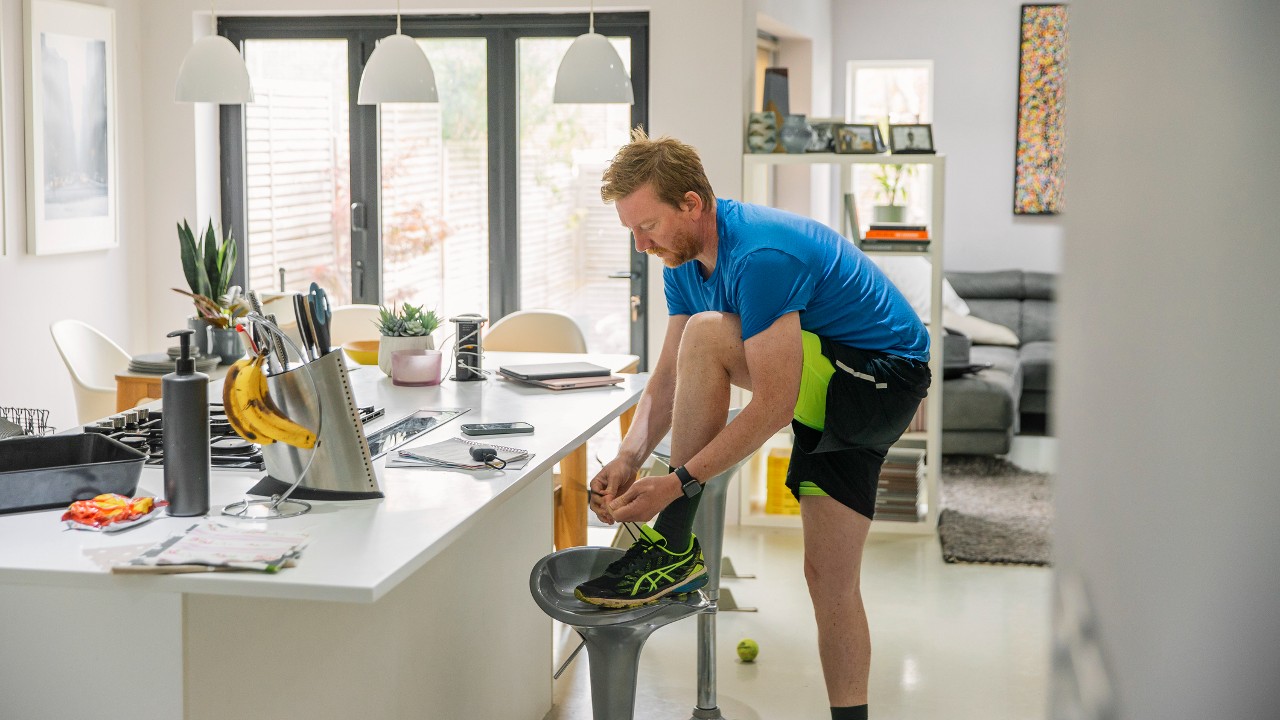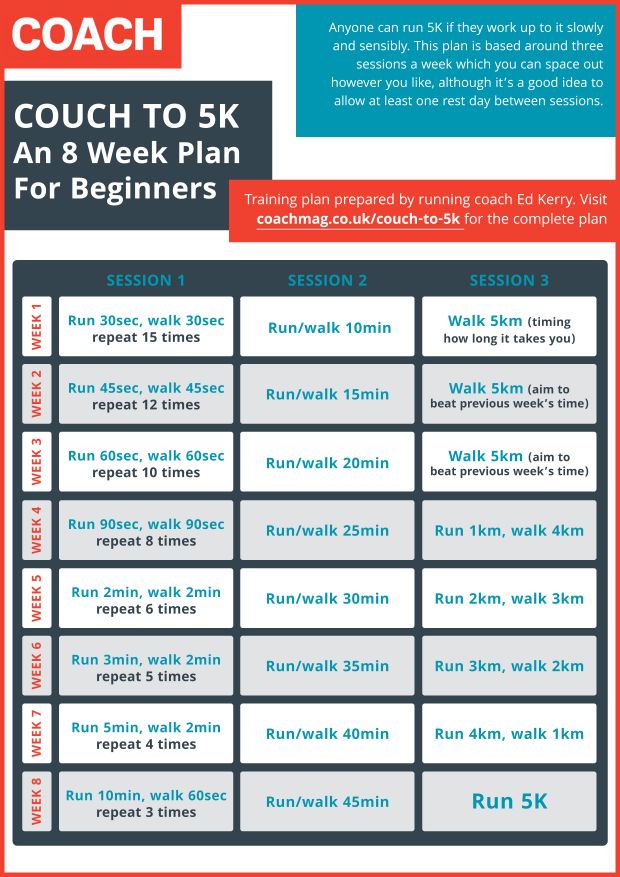Running For Beginners: Free Couch To 5K Plan
Even if you’ve never run before, follow this straightforward plan for beginners to run 5K without stopping in eight weeks

Running five kilometres without stopping is a great goal to have. It’s a target that only requires a pair of trainers, can be done anywhere and is something that almost anyone can achieve in a couple of months. Along the way you’ll also enjoy clear signs of how much you are improving your fitness, as you find that you’re able to run further every week, along with the other benefits of running.
It’s true that the first couple of times you run are probably not going to be that enjoyable because your body’s not used to it. But the good news is that your body will adapt in next to no time. This 5K training plan builds up the amount of running you do very slowly so your body can acclimatise gradually and you don’t have to worry that your legs will be too stiff to walk the next day. If you keep at it for a couple of months it is absolutely certain – and this is a 100%, take-it-to-the-bank guarantee – that you will start to enjoy running. You might even become addicted.
There are lots of great ways to work towards a first 5K. You can download one of the many couch-to-5K apps available or check in with your local running club to see if they put on any beginner’s training groups working towards a 5K. They almost certainly will, and this is perhaps the best way of all to start running, because you’ll be doing it with a group of like-minded beginners embarking on the same journey as you, guided by experienced runners who will be able to answer any questions you might have.
If you do want to fly solo, then another truly excellent way to build up to your first 5K is to follow this eight-week training plan.
8-Week Couch To 5K Training Plan
This couch to 5K plan is designed by running coach Ed Kerry and is based around three sessions a week. You can space these sessions out however you like, although it’s probably wise to aim for at least one rest day between them.
Pin Or Print This Couch To 5K Plan

Each week the first session is a mix of running and walking in repeated intervals. For example, in week one you run for 30 seconds then walk for 30 seconds, with the pattern repeated 15 times.
The easiest way to follow this session is to use an interval timer. There are plenty to choose from, but we recommend Seconds Pro Interval Timer, which has both Apple App Store and Google Play apps available. It’s easy to set the interval times and how many times you repeat the sequence, and the app works in the background so you can lock your phone and pop it in your pocket (or running armband, or running belt). It will also alert you using audio (through headphones if you wish) when the interval changes. All of the above is free, and the only thing you have to pay for is the ability to reuse a session, which requires a paid upgrade. If you’re happy to spend 30 seconds making each session from scratch then you’re all set.
Get the Coach Newsletter
Sign up for workout ideas, training advice, reviews of the latest gear and more.
The second session each week is simply a case of running or walking for a certain amount of time, with the mix entirely up to you.
In the third session of each week you’ll be covering 5K every time. For the first few weeks it will all be walking, but from week four you start to reduce the amount of walking and increase the distance you run by a kilometre each week until you’re ready to run the entire thing at the end of week eight.
To ensure you run the right distance, you can either keep tabs as you go with a free GPS tracker on your phone like Strava, or plan ahead using Map My Run’s route builder to work out where on a route you can stop running and start walking.
Week 1
| Session 1 | Run 30sec, walk 30sec, repeat 15 times |
| Session 2 | Run/walk 10min (freestyle) |
| Session 3 | Walk 5km, timing how long it takes you |
Week 2
| Session 1 | Run 45sec, walk 45sec, repeat 12 times |
| Session 2 | Run/walk 15min (freestyle) |
| Session 3 | Walk 5km (aim to beat previous week’s time) |
Week 3
| Session 1 | Run 60sec, walk 60sec, repeat 10 times |
| Session 2 | Run/walk 20min (freestyle) |
| Session 3 | Walk 5km (aim to beat previous week’s time) |
Week 4
| Session 1 | Run 90sec, walk 90sec, repeat 8 times |
| Session 2 | Run/walk 25min (freestyle) |
| Session 3 | Run 1km, walk 4km |
Week 5
| Session 1 | Run 2min, walk 2min, repeat 6 times |
| Session 2 | Run/walk 30min (freestyle) |
| Session 3 | Run 2km, walk 3km |
Week 6
| Session 1 | Run 3min, walk 2min, repeat 5 times |
| Session 2 | Run/walk 35min (freestyle) |
| Session 3 | Run 3km, walk 2km |
Week 7
| Session 1 | Run 5min, walk 2min, repeat 4 times |
| Session 2 | Run/walk 40min (freestyle) |
| Session 3 | Run 4km, walk 1km |
Week 8
| Session 1 | Run 10min, walk 60sec, repeat 3 times |
| Session 2 | Run/walk 45min (freestyle) |
| Session 3 | Run 5km |
Once you’ve done that, you might want to join a friendly group 5K like parkrun, or check out our 10K training plans.
Running For Beginners FAQs
How much should beginners run?
If you’re starting from scratch, aim to run, or do a mix of running and walking, three times a week, with at least one day of rest in between. Start with 10-15 minutes for each session, then start adding time after a week or two.
Will running help you lose weight?
Undoubtedly. Running is one of the best ways to lose weight, since you can just step out your door and do it. Any kind of running will burn calories and help get you into a calorie deficit, but if you want to drill down into the finer details read our interview with Dr Justin Roberts from Anglia Ruskin University’s Cambridge Centre for Sport and Exercise Sciences about running for weight loss.
What are the most common running injuries and how do you avoid them?
The most common cause of running injuries is doing too much running too soon, especially if you don’t allow yourself time to recover between runs. Following a progressive training plan that builds up gradually – like this one – is the best way to reduce your risk of injury. Common running injuries include shin splints, plantar fasciitis, achilles tendonitis and runner’s knee, but before that list scares you off, the health benefits of running far outweigh the risks.
Is running bad for your knees?
It’s a persistent claim so we went to orthopaedic surgeon and knee expert Professor Paul Lee to get the facts. The short answer is no, but if you’re worried about your knees it’s worth reading the long answer in our deep dive into whether running is bad for you knees.
What should I do if I get a stitch while running?
While stitches aren’t anywhere near as bad as the injuries above, they can still ruin a run and put you off running again. While it pays to try to avoid them, that’s easier said than done, since no-one is exactly sure what causes side stitches. In this side stitches explainer, Dr Rebecca Robinson, a sport and exercise consultant at CHHP London, runs through the possible causes of stitches and how you might avoid them by timing your meals right and adjusting your breathing pattern.
The Best Free Running Apps For Beginners
Strava
The best run-tracking app out there. Strava will use the GPS signal on your phone (or fitness tracker if you have one that does that) to accurately log the route and speed of your runs. It’s also so popular you may well find some friends already use it, and once you’ve connected in the app you can start sending each other kudos for your activities.
Download from App Store and Google Play
MapMyRun
MapMyRun is another great run tracking app that excels at route planning. Open the app wherever you are in the world and you can load local routes other runners have created and follow one on your phone during your run. We bet there’ll be plenty of 5K routes near you so you need not get bored doing the same circuit over and over again when following the plan below.
Download from App Store and Google Play
Running Heroes
Running is its own reward, but if you want to earn some more tangible ones with the kilometres you’re racking up, download Running Heroes. It links to apps like tracking apps like Strava and Fitbit, then converts the distance you cover into points that you can redeem for discounts on running gear and races.
Download from App Store and Google Play
None To Run
If you start the couch to 5K plan and find it too hard, or have been unable to complete one in the past, you should know that you are far from alone. Some find a typical couch to 5K plan ramps up the difficulty too quickly and a gentler introduction to running is required.
The None To Run plan has been created as an easier alternative. The plan builds up more slowly and uses time goals, rather than hitting a certain distance in each session. It also includes strength exercises that can help reduce your risk of injury when you start running.
You can download the plan for free on the None To Run website, and there’s also a paid-for app for the iPhone and Apple Watch that will guide you through each run (£4.99 a month or £29.49 a year).

Nick Harris-Fry is a journalist who has been covering health and fitness since 2015. Nick is an avid runner, covering 70-110km a week, which gives him ample opportunity to test a wide range of running shoes and running gear. He is also the chief tester for fitness trackers and running watches, treadmills and exercise bikes, and workout headphones.









